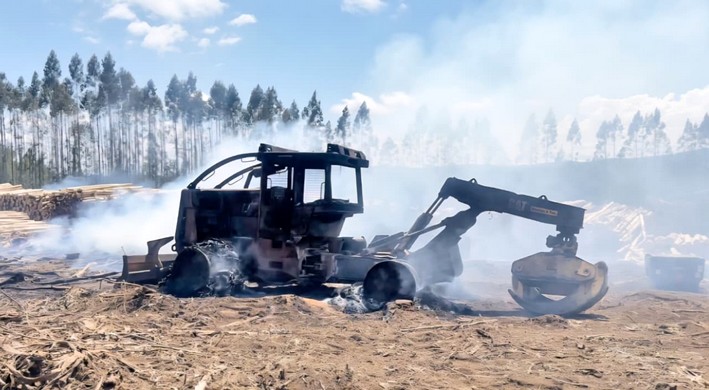From Traditional Biomass to Sustainable Bioenergy
Today, in Chile as in the rest of the world, we find ourselves on multiple fronts of "transition" of all kinds, where climate change, the pandemic situation, the economic crisis, the new constitution, and new economic models indicate that we are facing a process that, whether we like it or not, will change our perspective and the way we have been doing things.
The energy sector is not exempt from these changes, and given its significant responsibilities in the climate crisis due to the use of fossil fuels for generation, it has now reacted in such a way that it seems to position itself as the sector that will change the world through the integration of renewable energies and new fuels like Green Hydrogen. In other words, the energy sector has decisively seized the opportunity that every change offers, which in Chile has meant the successful incorporation of Non-Conventional Renewable Energies (NCRE), with certain periods where over 50% of electricity production is based on these energies, including conventional ones like reservoir hydropower. This has positioned our country as an example of energy transition, even setting more ambitious goals, such as the recent proposal in the Senate's Mining and Energy Committee to eliminate all fossil fuels from electricity generation by 2030, including natural gas—a notable step considering some countries would struggle to exclude it from their energy transition processes.
However, these great achievements have highlighted that the challenges are becoming harder to overcome when we look at the full picture. Today, the integration of NCRE has mainly been in solar and wind power, known as variable renewable energies because they depend directly on weather conditions—unless complemented with batteries that store energy for use during periods without sun or wind. Yet, this is more costly than simply generating and delivering power. Even with the significant investment in South America's most advanced solar plant with storage—Cerro Dominador—it was excluded from recent tenders, showing that not everything can be about "price."
How will we ensure electrical continuity with renewables alone? The electrical coordinator has called for keeping certain thermoelectric plants operational, as, for now, this is the only way to ensure stable generation. This is especially critical considering electricity accounts for only about 22% of the country's total energy consumption, distributed among the three major consumption sectors: industry and mining (38%), transportation (36%), and the commercial, public, and residential sector (22%).
What role does biomass play in these changes? From the Chilean Biomass Association, AChBIOM, we have also emphasized that biomass is the primary renewable energy source used today in our country and the world, ranking just below crude oil at 25% of the primary energy matrix. When compared to other renewables, these numbers are even more surprising, with Chile mirroring the global trend where biomass represents over 60% of renewable energy consumption. However, like other sectors, we too face a transition process. Part of the biomass used in our country is in the form of firewood, which has two main deficiencies that must be addressed.
The first of these lies entirely in the hands of national policy and, unfortunately, has long been neglected with the required seriousness. We refer to the need for a biofuels law that equips the State with regulatory tools to oversee the market and prevent the sale of wet and illegal firewood.
Illegality brings additional problems beyond environmental pollution, as it may come from forests without management plans approved by CONAF, leading to forest degradation. Another major issue the sector faces today is timber theft—how much of the stolen wood ends up in household stoves? Enacting the law currently under urgent review in the Senate is vital, though it has stalled since the start of presidential campaigns despite its urgency. Once the timber theft law is enacted, Comprehensive Biomass Centers (CIB) will play a crucial role, providing end consumers with traceable, quality-controlled fuels. Today, AChBIOM, together with the Ministry of Energy, CONAF, and the Energy Sustainability Agency, is developing technical and financial tools for CIB implementation in Chile through a CORFO public goods project.
The second deficiency in firewood use—the main heating source in central-southern Chile (over 80%)—is the need to replace equipment with more efficient technology. Progress has been made in market regulations, with a long list of SEC-certified heaters under strict standards. However, the State has not promoted a "firewood-for-firewood" replacement, as without a biofuels law or home insulation improvements, this alone is not seen as a positive change. The chosen alternative has been switching to pellets, where industrialization has proven capable of delivering consistent fuel quality with traceability, as it comes from formal industries like sawmills.
Highlighting the firewood issue has allowed pellets to be quickly adopted and recognized by the residential market. However, AChBIOM also aims to emphasize other sectors where biomass plays a critical role, especially in the energy transition due to its climate change implications.
Today, electricity from biomass is undoubtedly Sustainable Bioenergy, as it comes from regulated and managed sources, forming part of a Bioeconomy where forest products are vital for reducing the consumption of polluting materials like steel and cement in construction, plastics in packaging, and other uses—increasing the adoption of wood-based biomaterials. Similarly, there is a less visible sector with the same characteristics: industrial thermal energy use based on biomass, mainly in chip or shredded form from waste. This includes agroindustry, food processing, and the timber industry, using this energy, for example, in drying processes.
In Chile, 18% of energy in the Industry and Mining sector is Bioenergy, and we believe it could be higher, as certain sectors are not recorded in the Ministry of Energy's national balance. This sector is currently the largest consumer of fossilized energy, where electricity alone cannot meet high demand. If we aim to reduce fossil fuel consumption here too, Bioenergy presents a major opportunity to become the primary source.
On the other hand, the Ministry of Energy has launched the National Heat and Cold Strategy, aiming to make this sector more renewable and sustainable, aligning with the Carbon Neutrality Plan and the National Energy Policy 2050. Key goals include increasing the share of sustainable heat and cold energy to 45% by 2030 and 80% by 2050, reducing associated GHG emissions by 40% by 2030 and 65% by 2050, and ensuring at least 75% of the population meets their heating and cooling needs sustainably by 2050—all based on 2020 levels.
Considering all the above, this transition framework is a major opportunity. Through sustainable forestry and agriculture—and even individual sustainable behaviors like waste management—we can contribute more Sustainable Bioenergy for all. We must seize this opportunity and make it our own.

















